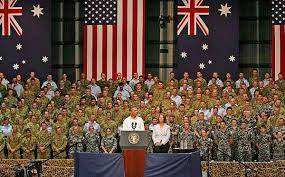Australia Willing to be the U.S. Policeman in the Pacific

The U.S. is ramping up pressure on Australia to support hostilities against China in Southeast Asia and the South Pacific. Last week in Sydney, the U.S. Ambassador to Australia, Arthur Culvahouse, said that “We’ll be pushing Australia to expand its step-up from the Pacific islands region to south-east Asia and to look north as well.” The U.S., Australia and like-minded countries need to win in this strategic competition, the diplomat said. The Ambassador emphasized that in consultations between American and Australian foreign and defense ministers, the two sides will focus their efforts to further strengthen the Pacific step-up strategy.
The US Ambassador told the gathering of business leaders last Tuesday that Australia “sits on the frontline of the great strategic competition of our time.” “If the security and prosperity enjoyed by our countries and the region is to continue, this is a competition that we must win,” he said in indirect reference to China being the competition that must lose.
Australia’s Pacific strategy was adopted in 2016 under Prime Minister Malcolm Turnbull to assert Australia’s position as the policeman for the U.S. in the South Pacific and Southeast Asia. The Pacific step-up strategy defines the Australian government’s approach to economic and strategic interaction with Pacific Island nations. However, this is just the friendly face of the strategy and rather it is primarily aimed at maintaining regional balance to counter China’s growing influence in the region. China signed an Action Program with eight Pacific Island nations at the October 2019 3rd China Economic Development Cooperation Forum and Pacific Islands held in Samoa. These countries’ support for China’s Belt and Road Initiative was confirmed.
As the U.S. is dealing with the growing influence of China and attempting to counter it all over the globe, Washington is relying on Australia to serve as a counterbalance to China in the South Pacific and Southeast Asia. However, as the coronavirus continues to grow out of control in the U.S., it is likely that Washington is going to take its focus off the South Pacific for a long while. This will give Australia autonomy to act on Washington’s behalf and it appears that U.S. President Donald Trump immensely trusts the Australians in this role, so-much-so that he honored the fellow Anglo-settler state by naming a new navy ship the USS Canberra, the only U.S. Navy warship named after a foreign city.
Australia wilfully wants to play a role that the U.S. assigned to them in Southeast Asia and the South Pacific so that it can more strongly assert its power on the region. Australia considers the small island countries of the South Pacific as an area within its sphere of influence. Canberra has a need to expand its weight in Southeast Asia, but finds this challenging as the region includes countries of larger populations and economies, such as Thailand and Indonesia.
Although Canberra wants to serve Washington’s interests in the region, Australia is a completely deindustrialized neoliberal country that does not have the means or capacity to challenge rising Southeast Asian countries and rather serves as a raw resource marketplace for the world. The U.S. is losing influence in Southeast Asia to China, and therefore Washington is relying on Australian support, hedging its bet on a common Anglo colonial-settler history to make Canberra receptive.
In this situation, Australia faces a very difficult choice as there is a clear divide between the economic community and the political class in regards to China policy. China is Australia’s most important economic partner, while the U.S. is Canberra’s most important security partner, so-much-so that Australia followed the U.S. to adventurist wars of aggression in Korea, Vietnam, Afghanistan and Iraq. China and Australia have established free trade areas and this agreement allows them to quickly increase the volume of bilateral trade. Therefore, the political will of Canberra is certain to face resistance from capitalist interests in the country as it wholly relies on China and other Southeast Asian countries for trade.
However, Australia is bound by the U.S. Indo-Pacific Strategy that aims to use American allies like Australia, Japan, India and others, to counter China’s increasing influence. This is done by enhancing military cooperation between these countries and does not serve any economic role like the Belt and Road Initiative. As China finds the Indo-Pacific Strategy as an aggressive force aimed against it, it is likely that under economic pressure, Australia will try to balance relations, despite the political will and determination of Canberra to act as the U.S’ policeman in Southeast Asia and the South Pacific.
*
Note to readers: please click the share buttons above or below. Forward this article to your email lists. Crosspost on your blog site, internet forums. etc.
This article was originally published on InfoBrics.
Paul Antonopoulos is a Research Fellow at the Center for Syncretic Studies.

